- Clone
- 7H22-E16 (See other available formats)
- Regulatory Status
- RUO
- Other Names
- BR3, BAFFR, BAFF receptor, TNFRSF13C, B cell-activating factor receptor, BLys receptor 3
- Isotype
- Rat IgG1, κ
- Ave. Rating
- Submit a Review
- Product Citations
- 6 publications
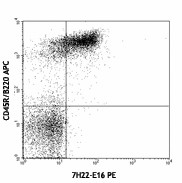
| Cat # | Size | Price | Quantity Check Availability | Save | ||
|---|---|---|---|---|---|---|
| 134103 | 25 µg | 123€ | ||||
| 134104 | 100 µg | 268€ | ||||
BAFF (B cell-activating factor belonging to the TNF family) receptor (BAFF-R) is one of the three receptors that bind to BAFF. It is a type III transmembrane TNF receptor family member. BAFF-R is expressed at high levels in resting B cells and at lower levels in activated B cells, a small subset of activated/memory CD4+ T cells. It is a major mediator of BAFF dependent co-stimulatory response in peripheral B and T cells. It was reported that the mice expressing defective BAFF-R have disrupted B cell maturation. BAFF receptor appears to be particularly important for the regulation of normal B cell survival and maturation, as well as in the pathophysiology of aggressive B-cell malignancies and autoimmune diseases.
Product DetailsProduct Details
- Verified Reactivity
- Mouse
- Antibody Type
- Monoclonal
- Host Species
- Rat
- Immunogen
- Mouse BAFF receptor transfected rat RBL cells
- Formulation
- Phosphate-buffered solution, pH 7.2, containing 0.09% sodium azide.
- Preparation
- The antibody was purified by affinity chromatography, and conjugated with PE under optimal conditions.
- Concentration
- 0.2 mg/ml
- Storage & Handling
- The antibody solution should be stored undiluted between 2°C and 8°C, and protected from prolonged exposure to light. Do not freeze.
- Application
-
FC - Quality tested
- Recommended Usage
-
Each lot of this antibody is quality control tested by immunofluorescent staining with flow cytometric analysis. For flow cytometric staining, the suggested use of this reagent is ≤0.25 µg per million cells in 100 µl volume. It is recommended that the reagent be titrated for optimal performance for each application.
- Excitation Laser
-
Blue Laser (488 nm)
Green Laser (532 nm)/Yellow-Green Laser (561 nm)
- Application References
-
- Ng LG, et al. 2006. Eur. J. Immunol. 36:1837.
- Ng LG, et al. 2004. J Immunol. 173:807.
- Batten M, et al. 2000. J. Exp. Med. 192:1453.
- Fu L, et al. 2009. Blood 113:4627.
- Product Citations
-
- RRID
-
AB_1626160 (BioLegend Cat. No. 134103)
AB_2203552 (BioLegend Cat. No. 134104)
Antigen Details
- Structure
- A type III transmembrane TNF receptor family member
- Distribution
-
Expressed on most B cells, a small subset of CD4+ T cells.
- Function
- Play an importance role in B cell development, maturation, and survival.
- Ligand/Receptor
- BAFF (BLyS)
- Cell Type
- B cells, T cells
- Biology Area
- Immunology
- Molecular Family
- CD Molecules, Cytokine/Chemokine Receptors
- Antigen References
-
1. Thompson JS, et al. 2001. Science 293:2108.
2. Schiemann B, et al. 2001. Science 293:2111.
3. Batten M, et al. 2000. J. Exp. Med. 192:1453.
4. Fu L, et al. 2009. Blood 113:4627. - Gene ID
- 72049 View all products for this Gene ID
- UniProt
- View information about CD268 on UniProt.org
Related FAQs
- What type of PE do you use in your conjugates?
- We use R-PE in our conjugates.
Other Formats
View All CD268 Reagents Request Custom Conjugation| Description | Clone | Applications |
|---|---|---|
| Purified anti-mouse CD268 (BAFF-R) | 7H22-E16 | FC |
| PE anti-mouse CD268 (BAFF-R) | 7H22-E16 | FC |
| Alexa Fluor® 647 anti-mouse CD268 (BAFF-R) | 7H22-E16 | FC |
| Ultra-LEAF™ Purified anti-mouse CD268 (BAFF-R) | 7H22-E16 | FC,Block |
Customers Also Purchased
Compare Data Across All Formats
This data display is provided for general comparisons between formats.
Your actual data may vary due to variations in samples, target cells, instruments and their settings, staining conditions, and other factors.
If you need assistance with selecting the best format contact our expert technical support team.
-
Purified anti-mouse CD268 (BAFF-R)
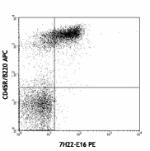
C57BL/6 mouse splenocytes stained with purified 7H22-E16 con... 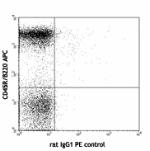
-
PE anti-mouse CD268 (BAFF-R)

C57BL/6 mouse splenocytes stained with 7H22-E16 PE (upper) o... 
-
Alexa Fluor® 647 anti-mouse CD268 (BAFF-R)
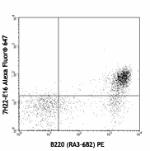
C57BL/6 splenocytes double stained with 7H22-E16 Alexa Fluor... 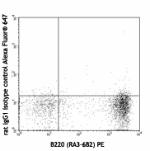
-
Ultra-LEAF™ Purified anti-mouse CD268 (BAFF-R)

C57BL/6 mouse splenocytes stained with purified 7H22-E16 con... 

Recombinant mouse BAFFR (Black Circles, Cat. No. 756506) bin...

 Login / Register
Login / Register 















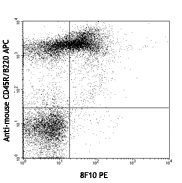







Follow Us